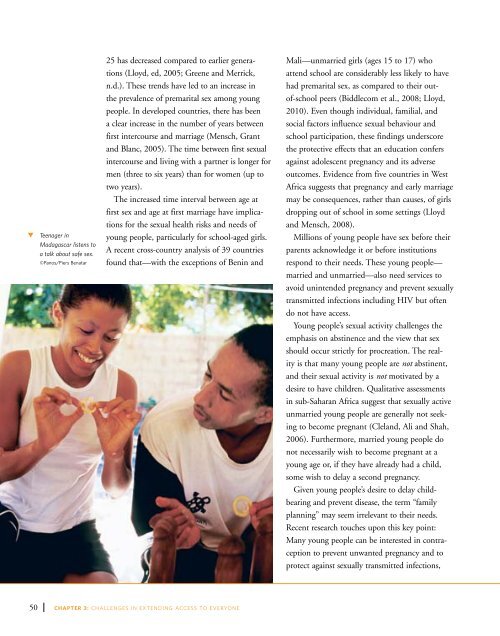State of World Population 2012 - Country Page List - UNFPA
State of World Population 2012 - Country Page List - UNFPA
State of World Population 2012 - Country Page List - UNFPA
Create successful ePaper yourself
Turn your PDF publications into a flip-book with our unique Google optimized e-Paper software.
t<br />
Teenager in<br />
Madagascar listens to<br />
a talk about safe sex.<br />
©Panos/Piers Benatar<br />
25 has decreased compared to earlier generations<br />
(Lloyd, ed, 2005; Greene and Merrick,<br />
n.d.). These trends have led to an increase in<br />
the prevalence <strong>of</strong> premarital sex among young<br />
people. In developed countries, there has been<br />
a clear increase in the number <strong>of</strong> years between<br />
first intercourse and marriage (Mensch, Grant<br />
and Blanc, 2005). The time between first sexual<br />
intercourse and living with a partner is longer for<br />
men (three to six years) than for women (up to<br />
two years).<br />
The increased time interval between age at<br />
first sex and age at first marriage have implications<br />
for the sexual health risks and needs <strong>of</strong><br />
young people, particularly for school-aged girls.<br />
A recent cross-country analysis <strong>of</strong> 39 countries<br />
found that—with the exceptions <strong>of</strong> Benin and<br />
Mali—unmarried girls (ages 15 to 17) who<br />
attend school are considerably less likely to have<br />
had premarital sex, as compared to their out<strong>of</strong>-school<br />
peers (Biddlecom et al., 2008; Lloyd,<br />
2010). Even though individual, familial, and<br />
social factors influence sexual behaviour and<br />
school participation, these findings underscore<br />
the protective effects that an education confers<br />
against adolescent pregnancy and its adverse<br />
outcomes. Evidence from five countries in West<br />
Africa suggests that pregnancy and early marriage<br />
may be consequences, rather than causes, <strong>of</strong> girls<br />
dropping out <strong>of</strong> school in some settings (Lloyd<br />
and Mensch, 2008).<br />
Millions <strong>of</strong> young people have sex before their<br />
parents acknowledge it or before institutions<br />
respond to their needs. These young people—<br />
married and unmarried—also need services to<br />
avoid unintended pregnancy and prevent sexually<br />
transmitted infections including HIV but <strong>of</strong>ten<br />
do not have access.<br />
Young people’s sexual activity challenges the<br />
emphasis on abstinence and the view that sex<br />
should occur strictly for procreation. The reality<br />
is that many young people are not abstinent,<br />
and their sexual activity is not motivated by a<br />
desire to have children. Qualitative assessments<br />
in sub-Saharan Africa suggest that sexually active<br />
unmarried young people are generally not seeking<br />
to become pregnant (Cleland, Ali and Shah,<br />
2006). Furthermore, married young people do<br />
not necessarily wish to become pregnant at a<br />
young age or, if they have already had a child,<br />
some wish to delay a second pregnancy.<br />
Given young people’s desire to delay childbearing<br />
and prevent disease, the term “family<br />
planning” may seem irrelevant to their needs.<br />
Recent research touches upon this key point:<br />
Many young people can be interested in contraception<br />
to prevent unwanted pregnancy and to<br />
protect against sexually transmitted infections,<br />
50 CHAPTER 3: CHALLENGES IN EXTENDING ACCESS TO EVERYONE
















